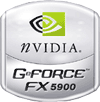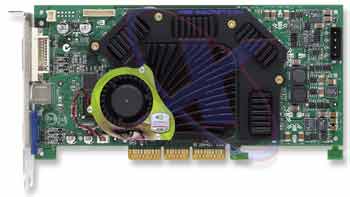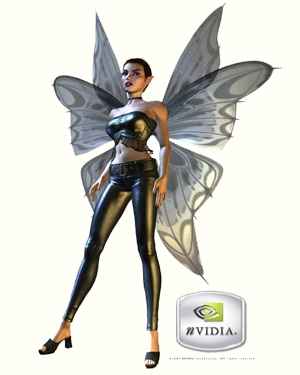

 NV35 - May 9, 2003
NV35 - May 9, 2003
nVidia has finally acknowledge publicly that the FX is a failure. Kudos to ATI for having beat the King at its own game.
But the R&D chambers in Santa Clara have not been idle. After a few heads rolled, the trolls brought out their whips again and the code goblins went back to their sweltering smiths. The product of their suffering is the New And Improved FX, the 5900.
Details on this product are sketchy at the moment, but it is known that the 256-bit bus has finally been admitted, even though DDR-II has not (yet).
In any case, the King has placed power and silence on an equal scale this time, and the Days of the Dustbuster seem to be over.
Not that they lasted very long anyway.
nVidia has released the final specs of its NV35. As you can see below, it is a scorcher. Depending on the views, the new FX 5900 is either faster (at Tom's Hardware) or slower (at Hardware.fr) than the ATI R9800. The explanation of these discrepancies has to do with the cheating issue that has arised over 3D benchmarking. In short, if you test with the industry-standard benchmarks, nVidia takes the cake, but if you test with independant benchmarks, ATI stays in the lead.
Personally I find the whole issue rather ridiculous. When Intel's P4 was being beaten to a pulp by AMD's new XP, pro-Intel fans were loudly clamoring that the benchmarks were flawed because the P4 could not use all of its power. Now that nVidia (and ATI too, let's face it) are trying to get the most out of their hardware, people are screaming bloody murder. What makes CPU-optimised code "more acceptable" than GPU-optimised code ? One argument may be that visual differences can make a large impact (like seeing through walls), whereas the speed at which a CPU gets to a result makes no difference if the result is the same. True, unfortunately, in the visual arena, everything is subjective and a matter of taste more than anything else.
Whether or not you believe either scenario is irrelevant. What remains is that the FX 5900 is a largely better FX than the 5800 was. Less noisy, more powerful and better than before, the FX 5900 is worthy of attention.
I will be interested when it gets down to the $200 mark
|
 Dawn - she really
was a bitch after all
|
The FX is dead, the 6800 is coming in great strides. Anand Tech has posted an article on the hows and whys of the dreadful FX failure.
What it all boils down to is essentially the fact that the NV3x line did not have enough shader power to do the job. Resources that were already tight were squandered in calculating depths and overdrawing, whereas the NV3x was already being pushed far and, therefor, did not have much room to play.
All in all, just a few minor design errors made the FX a dud, in spite of the general quality of the whole. Proof of this is the fact that the 6800 has essentially taken the FX architecture and upgraded it. The FX had four pixel pipelines, the 6800 has 16 (!). The FX had one shader unit per pipeline, the 6800 has two. That in itself makes for one hell of a workhorse. Add to that some more optimizations and presto ! Success at last.
The irony is that ATI is not going to have as much trouble keeping up this time around. Indeed, the 9800 architecture is quite a good performer, so ATI will need to push less in order to stay current. For example, ATI was first in going to 256-bit bandwidth. nvidia followed suit after.
In any case, the 6800 is going to be something of a painful victory for nvidia. Indeed, the 222 million transistors take up a lot of space on a 300 square millimeter die - that means less yields per wafer. Less yields should mean higher prices, but the limit is already tagged at $500 and the market will have a hard time swallowing another hike. So nvidia will end up with decreasing revenues on its flagship product. But we all know nvidia, and the 6800 architecture is marvelously scalable. That means we will be seeing cards galore as the 68xx series is declined in anything from 4 to 12 pipeline architectures.
Looks like nvidia will survive this time around.
| The GeForce FX | The 6800 series |